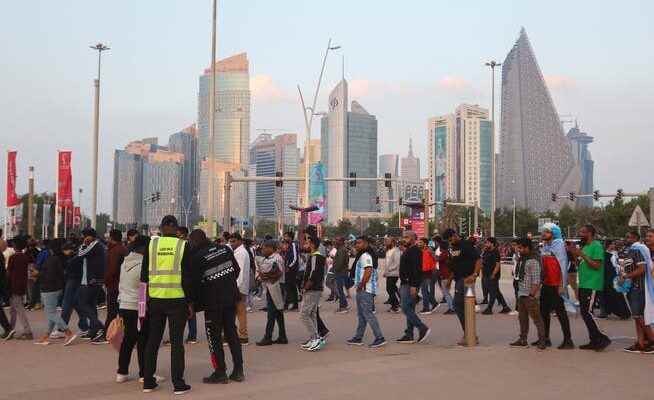Overcrowded metro stations, closed access routes, long delays – there was traffic chaos around the World Cup final site on Sunday. There was no accident, but the organizers seem to have underestimated the organizational challenge.
On the day of the World Cup finals, which is also Qatar’s national holiday, there is chaos around Doha.
The Lusail Stadium was still half-empty when the closing ceremonies of this World Cup started at just before 5pm local time. Even an hour later, when the finals kicked off, many of the 88,966 seats were still vacant. They were slow to fill in the opening stages of the game, which did not detract from the impressive atmosphere that provided a fitting setting for Argentina’s spectacular penalty shoot-out victory over France. The tournament organizers urged all ticket holders in advance to appear as early as possible.
However, it was not possible for most fans to arrive on time on the last World Cup match day because almost all routes to the final venue Lusail, which is half an hour’s drive outside of Doha, were blocked – as could be seen on many videos on Sunday.
The large number of fans overwhelms the metro network
The footage showed several overcrowded train stations. Doha’s central hub Msheireb, where all three metro lines converge, including the “Red Line”, the main artery of the tournament, was hardest hit. It not only takes fans to the final stadium, but also to the nearby Lusail Boulevard with its big screen and to the fan festival on the kilometer-long beach promenade of the glittering Qatari capital. The resulting rush of fans had already overstrained the Metro network several times during the tournament.
But the fact that the final was postponed to December 18th, Qatar’s national holiday, probably at the host’s request, led to the collapse. Because almost all shops were closed as a result, many locals took the opportunity to celebrate the occasion and attend the final at a fan festival.
However, the organizers did not seem to be counting on this huge crowd. They were overwhelmed with the mass event “World Cup Final”, which almost caused a major accident. Because the crowds at some subway stations blew up everything we had seen at this tournament. The congestion meant that sometimes even the police had to intervene and cordoned off the entrances to the bus stops – for more than an hour.
The result was long queues in front of the stations everywhere. Inside the metro stations, the security forces tried to calm the situation by standing in front of elevators and escalators so that no more people could get onto the platforms in the stuffy air. The metro, which opened in May 2019 and is actually one of the emirate’s prestige objects, had long since reached its capacity limit. Panic and claustrophobia sometimes reigned among the passengers on the trains. The operating company Qatar Rail, which had proudly announced that it had transported over 650,000 people the day before, sheepishly apologized “for all the inconveniences”.
In Qatar there were hardly any alternatives to the metro
The problem of getting there was exacerbated by the lack of transport alternatives. Although the World Cup was hosted less in a country and more in a city, the distances between the individual stadiums and meeting points are sometimes considerable. They cannot be managed on foot and are also difficult to get by by bus or car, because the access routes are largely blocked, so that there are again long walking distances. Numerous supporters who spontaneously switched to a taxi were dropped off miles from the final stadium and had to make their way through various barriers from there. England’s newspaper The Sun headlined: “Final Fiasco!”
To prevent such chaos, the host country tried to avoid crowds with far too many support staff in the tournament’s epicentres. As a result, direct access to stadiums, fan miles and metro stations was never permitted, even outside of rush hours. Instead, everyone had to pass through a labyrinth of barriers designed to mitigate the direct influx. The plan worked – but only until the final day. This required prudence and, above all, patience on the part of everyone involved so that the situation ended relatively mildly. It is said that there were no serious injuries or riots. Instead, the main focus was on jubilant pictures from all corners of Qatar because most football fans in the Gulf state sympathized with Argentina’s captain Lionel Messi.
The way back was correspondingly quiet and without incident – and nobody was in a hurry anymore.
